Tick bite fever in dogs (Biliary, Babesiosis)
ALL ABOUT TICK BITE FEVER IN DOGS (also known as biliary or Babesiosis)
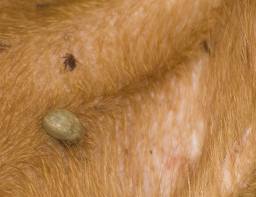
Tick bite fever in dogs or Canine Babesiosis affects dogs throughout the world. It is a blood parasite carried by ticks, that invades and multiplies inside red blood cells. Some strains of Babesiosis are relatively mild, such as those strains found in Europe and North America, but others, such as the strain found in Southern Africa can be lethal within a few hours. This article deals with Babesia found all over the world but with experience working in Africa where the most severe form exists.
[ad name=”Tweet”]
WHAT IS THE BABESIOSIS PARASITE?
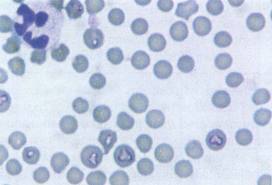
The parasite varies from a small, round parasite (Babesia gibsoni) to a banana shaped parasite, which is often seen lying in pairs inside the red blood cell. (Babesia canis – of which there are three subtypes – B. canis canis, B. canis rossi and B. canis vogeli, which all appear identical under the microscope. B canis vogeli is more common in the USA, and B. canis canis and B. canis rossi are more common in Africa. B. gibsoni, the smaller parasite is more common in Northern Africa, the middle East and Southern Asia. ) The parasite is a protozoan, which is a single celled organism, bigger than a bacteria, but smaller than the cell inside the body that it invades. The parasite is transmitted by ticks, in their saliva.
HOW DO DOGS GET BABESIOSIS?
Tick bite fever in dogs is a parasite transmitted by ticks which bite dogs in order to suck their blood. Ticks need blood to mature and lay their eggs and generally feed on the dog for a number of hours. The parasite sits in the salivary glands of the tick and slowly moves into the dog as the tick feeds. Moving from the tick into the dog takes a two to three days, so removing a tick quickly from your pet might prevent your dog getting biliary. Not all ticks carry the parasite, so if your dog is bitten it doesn’t mean that it will get Babesiosis. But it’s wise to use precautions, such as a long lasting spot on, to prevent your dog getting bitten in the first place. Once your pet has been bitten, it can take up to three weeks before he or she gets ill.

Once the parasite has entered the bloodstream of the dog, they enter the red blood cells and divide inside the cells. The parasites cause a reaction inside the red blood cells, making them ‘sticky.’ Thus many infected red blood cells get stuck in smaller blood vessels, such as those in the spleen.
It has also been shown that unborn puppies can contract the infection inside the womb. With the more severe forms of Babesiosis in South Africa, pregnant bitches may abort about 7 days after being infected. With the milder forms, puppies can be born infected with the parasite. As with any blood disease, the possibility of infection through blood contamination exists. Dogs with positive antibody titers should not be used as blood donors.
SIGNS OF TICK BITE FEVER IN DOGS (BABESIOSIS)
Due to the variety of strains found around the world, symptoms can vary tremendously from a mild anaemia to full blown shock. The symptoms are listed from the most common to the least common. The more severe symptoms are generally seen in Africa
1. ANAEMIA
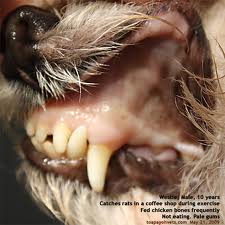
Seen as pale or whitish gums and inside of the eyelids. This can be mild to severe. The red cell count of a healthy dog varies but is usually greater then 35%. With the more severe forms, the red cell count can drop within hours to less than 14%, which means that the dog will need a blood transfusion in order to survive. The severity of the anaemia is often dependent on how the dog’s immune system reacts to the parasite. Many severe cases of Babesiosis go hand in hand with a condition known as Immune Mediated Haemolytic Anaemia (IMHA,) which is a condition in which the body, in an effort to rid itself of the parasite, starts to attack all red blood cells and destroy them, both cells with the parasite, and cells that are not infected at all. Dogs with IMHA need to be treated with an immunosuppressive drug such as cortisone to stop this reaction.
2. FEVER
This can also vary from a low grade fever, to a high fever (above 40 degrees celcius/centigrade). The fever is the body’s way of trying to kill the parasite. Dogs with fevers appear lethargic, often refuse to eat, and pant a lot to get rid of the excess heat. Not all dogs with Babesiosis have fevers so if your dog doesn’t have one, it doesn’t rule it out.

3. ANOREXIA OR POOR APPETITE
This is the main reason the dogs are brought into the vet for treatment. A dog with a high fever or anaemia usually refuses to eat.
4. PANTING OR RAPID BREATHING

This is usually due to a combination of the fever, anaemia and sometimes the shock reaction that takes place in the lungs – see no 9. for more details.
5. WATERHAMMER PULSE
This is a very heavy pulse, often felt with dogs with Babesiosis. The heart pounds as a reaction to both the fever and anaemia present in the system.
6. AN ENLARGED SPLEEN
This is commonly seen in all forms – the acute and severe to the mild and chronic forms. This is because the spleen is important in immunity and blood breakdown and storage. When the parasite enters the circulation, the spleen is important in breaking down the infected red blood cells trapped inside its small capillaries. It also stores red blood cells so if a dog becomes very anaemic it can contract and release the red blood cells to help the dog.
If there is an immune mediated anaemia, in complicated Babesiosis, the spleen will attack healthy red blood cells as well as infected ones, leading to a sharp drop in the red cell count.
7. JAUNDICE (ICTERUS)
This is a commonly seen symptom of complicated Babesiosis, where the body develops IMHA. Red blood cells are broken down very rapidly, far more rapidly than the body can cope with. When a red blood cell is broken down, the body normally makes use of the components of the blood and uses them to manufacture new blood cells. The red blood cells initially break down in the spleen or in the circulation into protein and haemoglobin. The Haemoglobin pigment is then broken down further and processed by the liver into bilirubin which has a yellow colour. The liver then excretes the bilirubin in the bile which gets emptied into the intestine and helps with digestion. If bilirubin builds up too fast, the liver cannot get rid of it fast enough and it stays in the circulation and leaks into the tissues as a yellow pigment – ‘jaundice.’ The bilirubin stains the whites of the eyes, the gums and the urine bright yellow.

When the liver is over worked in these cases of complicated biliary, it can swell and have difficulty in performing its normal day to day functions as well. Toxins can build up in the circulation as well as bile pigment that has been processed further, further staining the tissues a dirty yellow.
8. BROWN OR RUST COLOURED URINE (PORT WINE URINE)
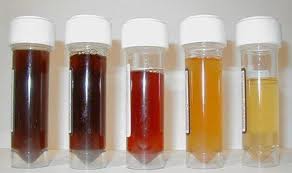
This is due to the body attacking the red blood cells in the circulation. The cells burst, releasing haemoglobin pigment into the bloodstream which is filtered through the kidneys, appearing as rust coloured or brown urine. This is a sign that a dog has complicated biliary and urgently needs to see a vet and usually be admitted into hospital.
9. VOMITING AND YELLOW TO BLACK DIARRHOEA
This is often caused by a combination of shock as the stomach, liver and intestines struggle to cope with the poor oxygen supply, and the liver having to work overtime to excrete bile due to the excessive breakdown of red blood cells, as well as bleeding from ulcers in the stomach and intestines.
10. SEIZURES, HOWLING AND DISORIENTATION

These can be due to either a low blood glucose levels, which is easily treated, or the parasite invading the brain and the extreme reaction of the body to the presence of the parasite in the brain and is often fatal.
11. SHOCK LUNG
Shock reaction in which the lungs fill with fluid, known locally as ‘shock lung.’ This is usually fatal, and quick in onset, but luckily rare, only seen in some hotter parts of the world, such as Southern Africa. It is also due to the body’s immune system reacting violently to the parasite. The lungs fill with fluid to the extent that the dog cannot get enough oxygen into the body. This usually occurs north of Pretoria in Southern Africa.
12. MUSCLE PAIN AND LAMENESS
13. CHRONIC BABESIOSIS
Babesiosis caused by B. canis vogelis is the least pathogenic form and is found in the USA. Many dogs with this chronic form may not show the more severe symptoms listed, and may show more of a ‘wasting disease,’ where they lose weight, may show low grade fevers, mild anaemia and have an enlarged spleen.
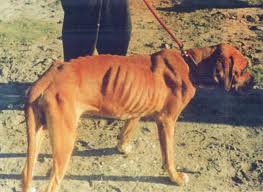
DIAGNOSIS OF BABESIOSIS
The diagnosis is, in most cases a simple diagnosis as the parasite can be picked up easily on a blood smear, which your vet can do at the surgery. The red blood cells with parasites tend to sludge in smaller capillaries, so an ear prick smear is best or a buffy coat smear made in a lab from a spun down sample of blood.
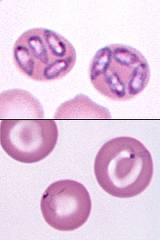
Your vet will also look at the blood smear to check for numbers of immature red blood cells – those will give an indication of how well the body is coping with the disease. Your vet will also examine the smear for the presence of small fragments of red blood cells known as Spherocytes – these indicate IMHA as they are pieces of red blood cells left after they have been broken down partially in the spleen. There are always a small number in circulation in any dog, but more than 50% spherocytes on blood smear are diagnostic for IMHA. These blood smears should be repeated by the lab.
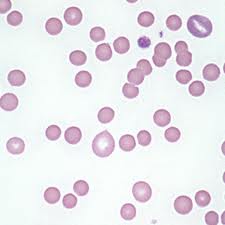
Sometimes, your vet may not see the parasite on a blood smear, but will suspect Babesiosis – in those cases, blood is send to a laboratory for testing. The tests run are known as the IFA test or the PCR test. If the PCR test is available, it is the better test to run. This can happen if your pet has been vaccinated, or if your pet has a mild strain.
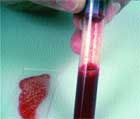
Once your pet has been diagnosed with Babesiosis, your vet may run an ‘in saline’ test on the blood sample taken. This will determine if your dog has immune mediated anaemia and whether your pet needs to be treated with cortisone or not. A Coombs test run in the lab is useless as animals with Babesiosis will have a positive Coombs test anyway due to the change in the red cell membrane caused by the parasite.
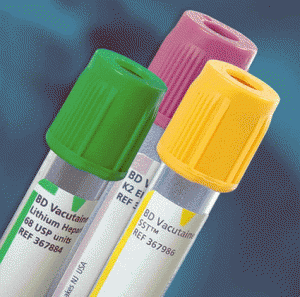
It is always advisable to run a full blood count and check the organ function with serum chemistry. A daily red cell count or Haematocrit should be run to assess how your pet is responding to the treatment. The liver is often affected, as well as the kidneys.
TREATING BABESIOSIS
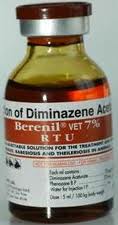
The most common drug used in Southern Africa is Diminizine aceturate, also known as ‘Berenil.’ This drug is given as a single injection and should not be repeated again within three weeks of the initial injection as it can be very toxic and cause brain damage. Dogs need to be weighed carefully and an exact dose given so brain damage is avoided. It should only be given by a licensed vet. This stops the parasite dividing and allows the body to clear the infection naturally. This drug is effective against both B. canis and B. gibsoni. It isn’t licensed for use in the USA.
The second most common drug is Imidocarb Diproprionate. This also relatively toxic drug is used in cases where the Babesiosis doesn’t clear with Diminazine treatment. It can be harmful to the kidneys so should not be used in a dehydrated or shocked patient until they are stabilized on intravenous fluids. This is the only drug approved by the FDA for use in the USA. Dogs can be injected with atropine prior to injection to minimize side effects. It is a painful injection for the dogs and can also cause salivation, tremors, vomiting and diarrhoea. It works better against B. canis than B. gibsoni.
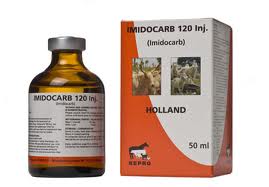
Trypan Blue is an old fashioned dye injected intravenously. Dogs treated with Trypan Blue develop blue or green tongues and mouths for weeks afterward. It is safe given i/v, but if it gets under the skin, it can cause the skin to slough off. It stops the parasite dividing and allows the body to clear the infection naturally.
A drug known as Phenamidine used to be used for treatment of Babesiosis twenty years ago but is no longer routinely used as dogs can vomit heavily about ten minutes after an injection and it also has other side effects.
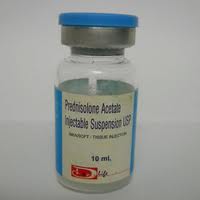
Dogs with complicated Babesiosis may need injections of a drug to suppress the over zealous immune system. The most commonly used one is cortisone. It is the drug of choice for IMHA as it is relatively safe used in the short term. Other immunosuppressive drugs include chemotherapy drugs, but which seldom need to be used.
Dogs with very low red blood cell counts will need full blood, packed red cells or Oxyglobin® transfusions in order to survive. Dogs with a low blood count do better with transfusions than without and the recovery time is shorter in most cases. Sometimes multiple transfusions are needed. Dogs can accept blood from any donar for the first transfusion, but after that, blood will need to be cross matched to ensure that their immune system will not break it down.
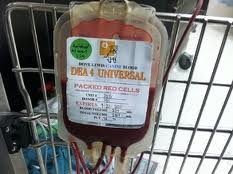
Intravenous fluids in the form of drips are often needed, especially where dogs are in shock or very jaundiced. The drips keep the dogs hydrated if they are not eating, help to flush out the kidneys and keep the circulation flowing to help prevent death by shock.
Dogs with low blood sugar can often seizure – this is more common in puppies and can mimic Cerebral Babesiosis – the biliary that affects the brain. Any seizuring dog should have the sugar tested prior to declaring it a hopeless case.
Dogs with jaundice often benefit from potassium supplementation in the drip. It helps them feel less nauseous and eat sooner as well as feel more energetic.
Dogs are often given vitamin B supplements as well as liver tonic tablet or liquid to go home with. These tonics provide iron to help dogs replace red blood cells as well as vitamin B to stimulate appetite and help the liver recover.
Dogs whose livers have taken a knock often benefit from Ursodeoxycholic acid – it helps the liver excrete bile and toxins more effectively.
Sucralfate is a chalky liquid or tablet given to coat the lining of the stomach. It helps to reduce bleeding in the gut that can be caused by high doses of cortisone and shock.
All dogs entering the hospital with ticks should be sprayed with an acaricidal spray or a top spot put on to kill the ticks, so they stop transmitting more parasites into the circulation and the ticks don’t get infected by the parasite and go on to infect another dog.
Puppies that are very anaemic should also be checked and treated for hookworms.
HOME CARE OF THE SICK DOG and WHAT TO EXPECT AT THE VET
This is not a disease that you can cure at home. Dogs always need to be seen by a vet and don’t wait a day or two to see if your dog feels better especially if you live in South Africa, as he or she may be dead by then. If your dog has what is known as ‘uncomplicated biliary/Babesiosis,’ your vet will weight him or her, check a blood smear, give one to three injections, send him home and ask you to come back for a consult a few days later as your vet will need to check the blood again under the microscope.
Once home, you need to watch your dog carefully. Uncomplicated biliary treatment usually makes them feel better in about 24 hours. if at any time your dog looks worse, or isn’t a lot better, your dog may have ‘complicated’ biliary/Babesiosis. This means your dog is suffering from another disease process on top of the blood parasite.
The most common is an overzealous immune system where IMHA develops, leading to a rapid drop in blood count, collapse, weakness , anorexia, puffing for air, bloody or brown urine, a rapid pulse, enlarged spleen and possibly jaundice.
Biliary complicated by other tick diseases can also occur. In South Africa the most common disease is Ehrlichiosis. If your dog has both, he will need tablets to treat the Ehrlichia, and possibly a blood test sent away if your vet suspects he may have both.
Shock lung is also part of complicated Babesiosis
Cerebral Babesiosis is also part of complicated Babesiosis
If your dog has complicated Babesiosis, your vet will have to admit him and put him on a drip or give a blood transfusion to save his life. Dogs with complicated Babesiosis may also die despite everything your vet can do especially if they have shock lung.
Home care that owners can do involves feeding a diet high in iron, such as red meat or liver. Ensure that a low fat diet is fed though as too much fat tends to strain the liver. Often a tonic or supplement is sent home with the pet that is given daily to build the vitamin B and iron stores of the body back up again. Until your dog has had a follow up check, the dog should be kept at home and not exercised at all. Strict tick control should be done especially in the summer months.
PREVENTION OF BABESIOSIS
Because ticks are the carriers of Babesiosis, tick control remains the best way of preventing your dog getting ill. Dogs in areas where there is long grass or open land or veld should have tick prevention every four weeks. A spot on that both repels and kills ticks is ideal – the most effective ones are available form your vet. Be careful when buying spot ons from the supermarket or pet store as there may be resistance to them as they are generally older products. Dogs can also wear an amitraz collar (only adults) or get dipped once a week as well in bad areas. Always speak to your vet about using different products simultaneously to make sure you aren’t poisoning your dog using the same chemical in three different ways.
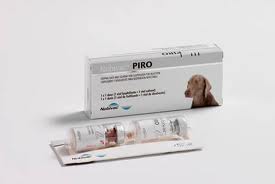
Vaccinating your dog against Babesiosis is highly recommended for dogs that hunt or spend time in open grassland, or veld. The vaccine is NOT included in your dog’s usual annual vaccinations and is given upon request as a separate injection. Two injections are given, a month apart, and thereafter every six months to keep immunity constant. The vaccine may not entirely prevent your dog contracting Babesiosis, but helps to prevent the severe, fatal form of the disease. Dogs that have been vaccinated, however, are more difficult to diagnose on blood smear and may need an antibody test at a lab to diagnose the disease. They also tend to show the milder, chronic from of the disease. Tick control is still mandatory with these dogs.
If you are planning to breed your bitch, have her tested to see if she is positive before mating her as it may affect the outcome of the pregnancy.
REFERENCES
http://veterinarynews.dvm360.com/dvm/article/articleDetail.jsp?id=60100

Leave a Reply
You must be logged in to post a comment.